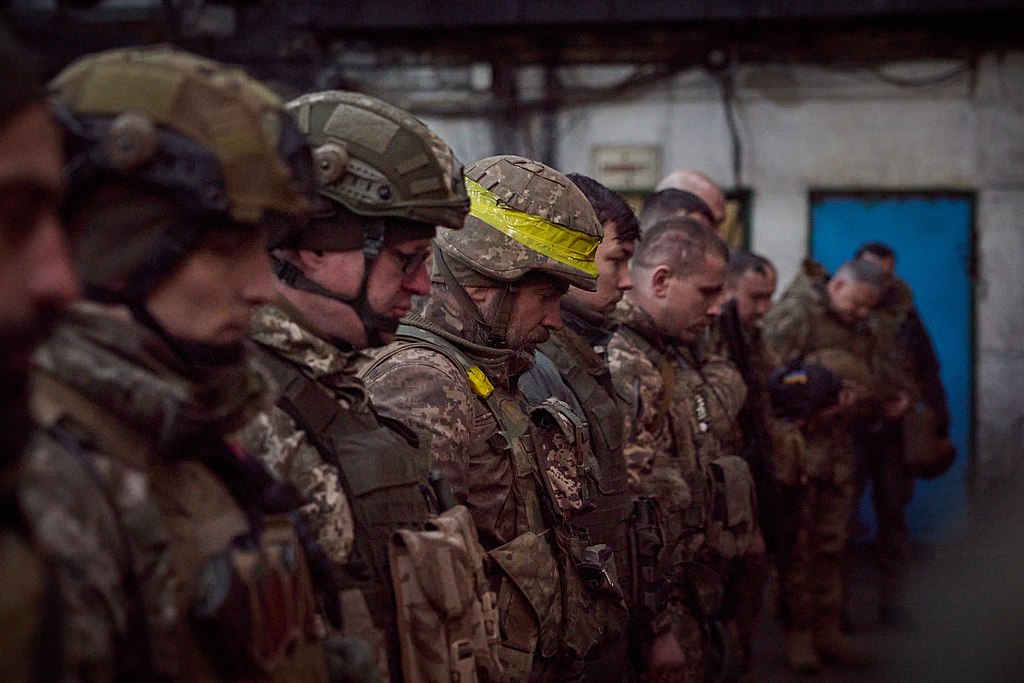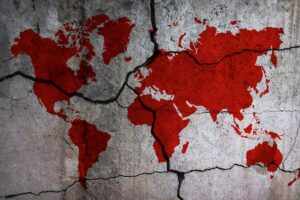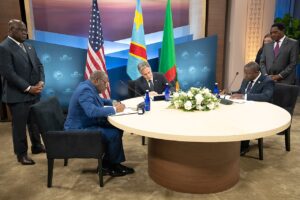The Red cell project
The Red Cell was a small unit created by the CIA after 9/11 to ensure the analytic failure of missing the attacks would never be repeated. It produced short briefs intended to spur out-of-the-box thinking on flawed assumptions and misperceptions about the world, encouraging alternative policy thinking. At another pivotal time of increasing uncertainty, this project is intended as an open-source version, using a similar format to question outmoded mental maps and “strategic empathy” to discern the motives and constraints of other global actors, enhancing the possibility of more effective strategies.
Reigning Assumption: Conventional thinking is that Ukraine must win, and Russia lose. In the last few months, as the Ukrainian counteroffensive has stalled and Russia has kept its economy going — fueled by continuing energy sales and defense industries churning out arms and armaments — some analysts have opined that the war is turning into an unwinnable one with no easy exit.
Total victory or defeat for either Ukraine (or Russia) cannot be dismissed as possibilities but they appear increasingly unlikely. Although there are growing worries about a Russian “breakthrough” in view of last year’s unsuccessful Ukrainian counteroffensive, Ukrainian perseverance remains strong, and the specter of total defeat would most likely energize additional European and U.S. military support to prevent not only a Ukrainian collapse but also far-reaching damage to Western prestige. More likely are the scenarios below, which deal with situations in between the extreme endings of victory or defeat and focus on how a middle-ground outcome in the Russo-Ukrainian War could occur.
Frozen Conflict but No Negotiated Cease-Fire
The “Kremlin has long used frozen conflicts to extend their reach beyond Russian borders,” according to researcher Erik J. Grossman at the U.S. National War College. In Moldova, for example, Russia “has backed the pro-Russian regime in the breakaway region of Transdniestria since 1992. In 2008, Georgia faced a conventional Russian invasion in support of the separatist governments in South Ossetia and Abkhazia.” More recently, Moscow invaded Crimea in February 2014 and started backing pro-Russian separatists in the Donbas, the backdrop to the current war. As in the Moldovan and Georgian cases, a frozen conflict occurred after most of the fighting ceased, and there may come to be a de facto cease-fire in and talks in Ukraine, but no agreement. According to Grossman, such frozen conflicts serve the Kremlin’s purpose of countering “the growth of Western alliances in the region.” In other words, frozen conflicts are a solution to the problem of creeping European Union (EU) and NATO influence in the post-Soviet space, which Moscow is otherwise unable to thwart.
Grossman’s article was written before the 2022 outbreak of the Ukraine War, but even when the article was published in 2018, it was clear that Russia was having difficulty turning the Donbas into a frozen conflict because Moscow was facing Western military and political support for Ukraine. In the other cases, Russia acted more openly and mostly without Western interference.
In this scenario, a frozen conflict comes about after Western arms shipments diminish, undermining Ukraine’s offensive capabilities. Former President Donald Trump has encouraged congressional allies to vote against aid to Ukraine, and has been critical of weapons transfers.. A second Biden administration would continue to militarily support Ukraine but might face more Republican opposition and be unable to pass needed legislation. Ukraine would most likely try to continue fighting with the Europeans ramping up Kyiv’s supplies of weapons. But unless Ukraine makes gains, European governments, bereft of U.S. backing, will probably face pressures to negotiate with Moscow. Trump or other allied leaders might try to make a deal with Putin, but Moscow’s conditions are likely to be too stringent. The Ukrainian government and people may also be opposed to settling the conflict and effectively ceding a fifth of their territory to Russia. With Moscow’s war economy keeping his popularity high, Russian President Vladimir Putin may see some advantages with a frozen conflict so long as it keeps a rump and weakened Ukraine out of NATO.
Probability: The election of Trump along with cuts in U.S. military support increases the chances that Ukraine will not be able to make significant gains, but Kyiv probably won’t want to end the fighting and settle for a diminished homeland. The political costs of acceding to Putin’s conditions are also likely to be too high for allied leaders.
Cease-Fire Agreement
This is a variant of the frozen-conflict scenario above but, in this case, the drive to end hostilities would come from domestic fatigue in Ukraine and Russia, forcing, over time, a negotiated cease-fire. On the Ukrainian side, the growing scarcity of young recruits will also be a factor determining Kyiv’s ability to continue fighting. Already, the average age of the latest recruits is in the 30-40-year range rather than the usual 18-24 years. Kyiv might also worry that the longer the war trails on, the less likely it is that a large number of Ukrainians will return to their homeland from EU countries. Refugee centers in Poland have closed because “many Ukrainians ha[ve] become ‘independent’ and found their own lodgings,” either in Poland, other EU countries, or have gone back to Ukraine. Although still supportive of the war, those who have not returned to Ukraine may be less eager to leave the lives they have created for themselves elsewhere, making Ukraine’s unfavorable demographic prospects even darker. Ukraine’s birth rate is barely over one child per woman and the likeliest outcome for Ukraine is that birth rates fall even further, as they did in Kuwait, Sri Lanka, and Armenia during wartime.
In this scenario, the Russian public would also begin to grow tired of the mobilizations and duration of the conflict. Russians do not want the country to be seen losing, but already today, about half of those polled by the Russian nongovernmental research organization Levada have consistently supported a cease-fire, including up to one-third of those who say they support the actions of Russian troops. If Russian forces can no longer appear to make large gains without additional call-ups, pressures could grow on the Kremlin to agree to a negotiated cease-fire.
Probability: During the next several years, Russia and Ukraine could begin to explore a cease-fire with the help of a mediator like Turkey, if the war continues to be one of attrition. This process might start with a series of temporary cease-fires over, for example, Orthodox Christmas and grow into a more permanent cease-fire with support from backers on both sides for a stop in the fighting. A cease-fire would leave Kyiv in a security limbo unless it was given security assurances from NATO countries about continued help in event of new fighting. There may be other questions that would need to be dealt with—such as prisoners, refugees, etc—that over time would lead both sides to start talks on an armistice (see below) should the peace hold.
Subsumed into a Larger East-West Conflict
Russian Foreign Minister Sergey Lavrov has said that “there is a ‘serious’ risk of World War III” [with the Russo-Ukraine War], accusing “NATO of waging a proxy conflict with Moscow.” Ukrainian President Volodymyr Zelenskyy also sees the fight in broader terms, emphasizing in his many speeches that “this war is a struggle between life and death, between normality and madness, between creation and destruction.” A widening war could start with Ukrainian forces increasing their attacks on targets inside Russia. As the frequency of such attacks ramps up, Russia might decide to respond by launching missiles on NATO arms depots in Poland, which could escalate into a NATO-Russia clash.
Alternatively, the Russo-Ukraine could be subsumed in a broader conflict between U.S./NATO and Russia/China. A Sino-U.S. military conflict over Taiwan is not a remote possibility. Such a conflict could occur if Taiwan declares independence and Beijing retaliates militarily, prompting the U.S. to intervene to protect the island. Russia, with China’s backing, could then widen the scope of the Ukraine War to include NATO, hoping that U.S. forces would be overstretched in fighting a war on two fronts thousands of miles apart. For Ukraine, an escalated conflict might be welcome, unleashing NATO’s full force against its invading neighbor. Moscow’s use of tactical nuclear weapons would be likely if it found itself losing in such a widened contest.
There would be no real winners, but whichever side prevailed would determine the fate of Ukraine, as well as the contours of the global system. For centuries, Ukraine has been part of the “bloodlands” comprising most of the Baltics and Eastern Europe that have been fought over or at times diplomatically carved up by neighboring great powers: Russia/Soviet Union, Prussia/Germany, and Austria/Holy Roman Empire/Austro-Hungarian Empire. In this scenario, Ukraine would again be the pawn in a much larger conflict.
Probability: Though substantially less likely than the frozen conflict or cease-fire scenarios presented above, a larger East-West conflict cannot be ruled out. This outcome depends on whether U.S.-China tensions continue to escalate.
Korean-Style Armistice
Two key factors shaped the “freezing of the Korean War” and the eventual 1953 armistice, which has held ever since. First, there was a military stalemate along the 38th parallel, which was Korea’s original North-South border. Second, the great powers (China, the former Soviet Union, and the United States) all wanted to end the war. Armistice talks began in July 1951 and were only concluded with an agreement two years later.
Achieving a successful armistice to stop the Ukraine War would take many months if not years. At the moment, Russia and Ukraine are far from seriously considering an end to the fighting. Putin is feeling confident; the Russian economy is doing well despite sanctions; and Ukraine’s poor counteroffensive might suggest to Putin that Russia could be successful in conquering more territory in the four oblasts — Donetsk, Kherson, Luhansk, and Zaporizhzhia — that the Kremlin has formally annexed. Putin has recently called on the U.S. to begin peace talks that would “cede” Ukrainian territory to Russia — a demand that might be accepted by a Trump presidency but would most likely be rejected by Ukraine and most NATO members.
However, one can imagine circumstances in which an armistice would come about. For example, if during the next few years there is little movement on the ground by both Ukrainian and Russian forces, then both sides might be more open to a negotiated cease-fire (as discussed above), which could be a step on the way to an armistice that had the backing of NATO members. For Ukrainians, a Korean-like armistice might still be a difficult step should Kyiv be unable to recapture all its lost territories. An armistice that relinquishes control over portions of eastern, southern, and Crimean territories might seem the equivalent of ceding them to Russia.
Probability: Under present conditions, an armistice looks very unlikely and is only possible in the medium term after a cease-fire. If the Korean case is any guide, achieving an armistice would take years.
Peace Agreement Between Ukraine and Russia
If the armistice is over the horizon, a peace agreement is even more inconceivable and might not happen unless and until a new Russian leader wants to reestablish ties with the West and is willing to negotiate a deal. The Korean armistice is a testament to the difficulty of moving beyond an armistice to a peace treaty. (There has been no peace treaty to end the Korean War.) A peace treaty would be a bigger hurdle, particularly because Ukraine and likely most NATO members would insist that Putin or his successor admit Russia’s wrongdoing and provide reparations. Signing a peace treaty that involves the U.S. would require approval by two-thirds of the U.S. Senate, which is difficult under any circumstances and unlikely if Putin is still in charge of Russia. Realistically, any peace treaty could only be made with a post-Putin government wanting to rebuild ties with the West, most likely for economic reasons.
Finally, it is worth noting that peace treaties have gone out of fashion no matter the circumstances of a war. Academic scholar Tanesha Fazal has examined how wars end going back to the 19th century, and she has found that while 75% of 19th-century interstate wars ended with peace treaties, there was a drop-off to 40% for all of the 20th century, and a “mere” 15 percent have ended through a treaty since 1950. Ukraine and Russia are very unlikely to beat these odds.
Probability: Close to nil in the foreseeable future.
The Red Cell thanks the Swedish Defence University for its support in the research and writing of this article.




